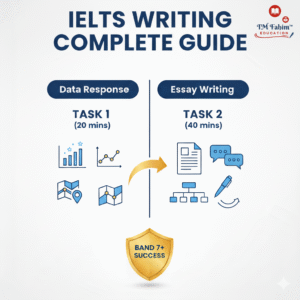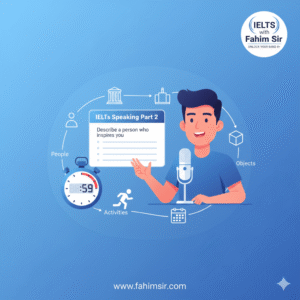“Good essays don’t just describe problems — they explain causes and build logical solutions.”
— Fahim Sir
The Problem–Solution Essay is super common in IELTS Writing Task 2. The examiner wants to see if you can spot real issues, explain why they happen, and suggest smart, workable solutions—all using clear, academic language.
This guide will break down exactly how to plan, structure, and write a high-scoring essay, using this popular example question:
Students are becoming more and more reliant on technology. What are some of the problems associated with reliance on computers, and what are some possible solutions?
1. Kick-Start Your Plan (The 5-Minute Rule)
Don’t start writing right away! Spend 5 minutes planning. A great plan prevents repeating ideas and keeps your essay focused.
Your task has two clear jobs:
- Identify and explain problems related to students using computers too much.
- Suggest realistic solutions with strong reasons.
Think about your ideas first. For problems, consider things like copying from the internet (plagiarism) and losing the ability to think for themselves (lack of critical thinking). For solutions, think about teaching better research skills and using software to check for copying.
2. The Must-Have 4-Paragraph Structure
A clear essay structure is your secret weapon for getting a high cohesion and coherence score. Stick to this simple 4-paragraph model:
Introduction
Start by saying the topic (technology reliance) in your own words. Then, state clearly what your essay will cover (e.g., “This essay will explore the main problems this causes and propose two practical solutions.”).
Body Paragraph 1 – Problems
Introduce the main issue (e.g., how over-reliance hurts learning) with a clear topic sentence. Explain the problem clearly (e.g., students copy ideas instead of creating their own). Finish with a quick, related example (e.g., this can lead to students losing research skills).
Body Paragraph 2 – Solutions
Introduce your solutions (e.g., critical thinking lessons). Explain how this solution fixes the problems mentioned in Body 1. Show the positive outcome as a result (e.g., this promotes independent thought).
Conclusion
Quickly bring together the main problems and solutions (e.g., “In summary, dependence on technology causes plagiarism, but this can be fixed by teaching better skills and using detection tools.”). End with a short final comment or prediction.
3. High-Scoring Vocabulary
To move past a Band 6, you need formal, academic language and strong linking words.
To start a new point, use words like Firstly, Secondly, or Furthermore. To show contrast, use However or On the other hand. To show a cause and effect, use Therefore, Consequently, or As a result. Use For instance or For example when providing examples.
Key Phrases for Problems & Solutions
- Introducing Problems: One major drawback is that…, A significant issue arises when…
- Explaining Causes: This happens as a result of…, The main reason behind this is…
- Introducing Solutions: A possible remedy could be…, This issue can be addressed by…, One effective measure would be to…
Must-Use Technology Vocabulary
Avoid simple words! Use these for precision: Over-reliance on technology, Digital literacy, Critical-thinking ability, Intellectual development, Academic integrity, and Plagiarism detection software.
Try this: “Excessive reliance on digital resources can weaken students’ critical-thinking ability.”
4. Common Mistakes to Avoid
Even good students lose points on simple errors. Don’t make these mistakes:
- Missing a Part: You must discuss both the problem and the solution equally.
- Informal Tone: Never use informal words like “kids,” “a lot of,” or “really.” Keep it formal!
- Too Much “I”: Avoid personal pronouns like I, you, or my (unless specifically asked for an opinion).
- Bad Examples: Use logical examples (e.g., “a study at a major university”)—not personal stories.
- Word Count: Aim for 270–300 words. Writing too much (over 320 words) often means more mistakes and takes up too much time.
5. Final Thoughts: The Logic Check
“High-band IELTS essays show logical progression — every idea connects to the question.”
— Fahim Sir
The Problem–Solution essay is really a test of your logical thinking and your ability to write precisely. Mastering this format will boost your Writing Task 2 score and make your overall academic writing much stronger.
Ready for personalized feedback on your essays? Join IELTS with FAHIM Sir – available both online and offline. Every batch includes special essay correction sessions, vocabulary training, and full mock test practice designed to build your writing confidence!






